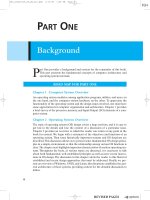Operating system internal and design principles by williams stallings chapter 06
Bạn đang xem bản rút gọn của tài liệu. Xem và tải ngay bản đầy đủ của tài liệu tại đây (634.33 KB, 51 trang )
Concurrency: Deadlock and
Starvation
Chapter 6
1
Deadlock
• Permanent blocking of a set of processes that
either compete for system resources or
communicate with each other
• No efficient solution
• Involve conflicting needs for resources by two
or more processes
2
3
4
5
Reusable Resources
• Used by only one process at a time and not
depleted by that use
• Processes obtain resources that they later
release for reuse by other processes
• Processors, I/O channels, main and secondary
memory, devices, and data structures such as
files, databases, and semaphores
• Deadlock occurs if each process holds one
resource and requests the other
6
Example of Deadlock
7
Another Example of Deadlock
• Space is available for allocation of 200Kbytes,
and the following sequence of events occur
P1
...
Request 80 Kbytes;
...
P2
...
Request 70 Kbytes;
...
Request 60 Kbytes;
Request 80 Kbytes;
• Deadlock
occurs if both processes
progress to
their second request
8
Consumable Resources
• Created (produced) and destroyed (consumed)
• Interrupts, signals, messages, and information
in I/O buffers
• Deadlock may occur if a Receive message is
blocking
• May take a rare combination of events to cause
deadlock
9
Example of Deadlock
• Deadlock occurs if receive is blocking
P1
P2
...
...
Receive(P2);
Receive(P1);
...
...
Send(P2, M1);
Send(P1, M2);
10
Resource Allocation Graphs
• Directed graph that depicts a state of the
system of resources and processes
11
Resource Allocation Graphs
12
Conditions for Deadlock
• Mutual exclusion
– Only one process may use a resource at a
time
• Hold-and-wait
– A process may hold allocated resources
while awaiting assignment of others
• No preemption
– No resource can be forcibly removed form a
process holding it
13
Conditions for Deadlock
• Circular wait
– A closed chain of processes exists, such that each
process holds at least one resource needed by the
next process in the chain
14
15
Possibility of Deadlock
• Mutual Exclusion
• No preemption
• Hold and wait
16
Existence of Deadlock
•
•
•
•
Mutual Exclusion
No preemption
Hold and wait
Circular wait
17
Deadlock Prevention
• Mutual Exclusion
– Must be supported by the operating system
• Hold and Wait
– Require a process request all of its required
resources at one time
18
Deadlock Prevention
• No Preemption
– Process must release resource and request
again
– Operating system may preempt a process to
require it releases its resources
• Circular Wait
– Define a linear ordering of resource types
19
Deadlock Avoidance
• A decision is made dynamically whether the
current resource allocation request will, if
granted, potentially lead to a deadlock
• Requires knowledge of future process request
20
Two Approaches to
Deadlock Avoidance
• Do not start a process if its demands might
lead to deadlock
• Do not grant an incremental resource request
to a process if this allocation might lead to
deadlock
21
Resource Allocation Denial
• Referred to as the banker’s algorithm
• State of the system is the current allocation of
resources to process
• Safe state is where there is at least one
sequence that does not result in deadlock
• Unsafe state is a state that is not safe
22
Determination of a Safe State
Initial State
23
Determination of a Safe State
P2 Runs to Completion
24
Determination of a Safe State
P1 Runs to Completion
25









